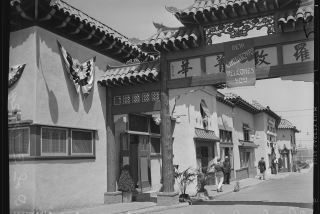Echoes From Bitter Past in South L.A.
My first visit to South Los Angeles was during the Watts riot.
I’d been brought down from the Associated Press Sacramento bureau to help with the coverage. One day, my AP colleague Jim Bacon and I--both white-- were dispatched to “Charcoal Alley,” around 103rd Street and Central Avenue, to find out why everyone was angry enough to burn down stores.
Bacon could make friends with anyone, and soon we were surrounded by several black men giving us a rundown on their grievances--police brutality, bad health care and economic exploitation by store owners who didn’t live in the neighborhood.
I am taking you down memory lane because some of the same basic complaints that Bacon and I heard on that hot August afternoon are being voiced today in South L.A., more than a quarter-century later.
Nobody knows this better than Larry Aubry, who’s on the staff of the Los Angeles County Human Relations Commission. Aubry, who is black, and a fellow staff member, Jai Lee Wong, a Korean-American, have been working long hours, seven days a week, to cool down the South L.A. neighborhood around 91st Place and Figueroa Street; there, in an incident still under investigation, a Korean grocer shot and killed a 15-year-old black girl, Latasha Harlins.
Aubry and Wong spend their days talking to store owners, teachers, parents, gang members, cops, African-Americans, Korean-Americans, Latinos--anyone who can help defuse what is clearly a tense situation.
Tuesday, Aubry and I talked about the situation in South L.A.
His most immediate concern is friction between African-American residents and Korean-Americans, who own small liquor stores and markets. Never good, relations have worsened significantly since the shooting.
Compounding matters, Harlins’ death followed by about two weeks the beating of Rodney King, a black motorist, by white Los Angeles police officers. These two traumatic events, though seemingly unrelated, clearly have provided a focus for long-simmering feelings of neglect among the city’s African-Americans.
“They tie in indirectly,” Aubry said of the two incidents. “The black community feels put upon.”
I’ve seen that, too, at candidates’ forums for the April 9th election in the 8th and 9th City Council districts, both with large African-American populations. In questions from the audience, or in casual conversation, the Harlins killing and the King beating inevitably are tied together in a single expression of outrage.
Behind the immediate outrage, however, run several deeper, more-complicated trends.
Black political power is threatened with decline. Latinos are now the majority in much of South L.A, moving into black neighborhoods as African-Americans depart for the suburbs.
Political power translates into crucial low-skill jobs. For example, most of the workers at Martin Luther King Jr./Drew Medical Center in South L.A. are black. The patients are increasingly Latino. Latinos want more jobs there.
The King hospital issue is especially hot. King was built after the riot because there was no hospital in the area. It has great symbolism for blacks.
Underlying all this are the tough living conditions in the poor parts of South L.A., where health care is scarce or nonexistent, markets are few and waiting for a bus can be risky business. And now there is concern about cops.
While it’s possible to write a bleak scenario from all this outrage and anxiety, Larry Aubry and Jai Lee Wong believe there is cause for hope.
They have before them an intriguing lesson of the Watts riot. When fellow reporter Bacon and I delved into the causes of the riot, the young black men complained to us of Jewish store owners taking money from the neighborhood without putting any wealth back. Some of the stores burned on “Charcoal Alley” were Jewish-owned.
There was great bitterness between blacks and Jews as the summer of 1965 ended. But there was goodwill too. It was particularly noticeable among liberal Jewish political activists gathering around a black ex-cop then serving on the Los Angeles City Council. From the anger of Watts, from the ashes of those stores, came a black-Jewish political alliance that elected Tom Bradley as mayor in 1973, and has helped keep the city cool.
Immediately after Latasha Harlins’ death, Aubry and Wong met with the Black-Korean Alliance, a group of community and business leaders formed in 1986 after three Korean-American merchants were killed by blacks in robberies.
The group has met frequently since then and has sent messages of peace to the African-American and Korean-American communities. Hopefully, the message will be heeded this time before the fire, and the ashes.
More to Read
Sign up for Essential California
The most important California stories and recommendations in your inbox every morning.
You may occasionally receive promotional content from the Los Angeles Times.










